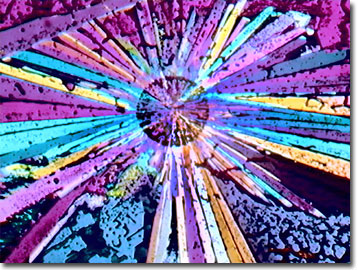Polarized Light Digital Image Gallery
Magnesium Sulfate
Large crystals of magnesium sulfate are rare, while crusts and massive forms are much more common. Epsomite (the mineral form of magnesium sulfate) forms as a precipitation from vapors (efflorescent) on limestone cave walls and on the walls and timbers of deep-shaft mines. In addition to the solubility of the crystals, the bitter, salty taste of epsomite is very characteristic of the compound. The dust of the salt is irritating to the eyes and throat as may be experienced by exposure to dry lake beds.

In the early 1600s, the sleepy village of Epsom, England was transformed into Britain's first spa town because of its healing waters that contain significant levels of magnesium sulfate. Medical uses of magnesium sulfate include soaking in Epsom salt solutions to relieve aches and pains, and taking the mineral as a dietary supplement to reduce the debilitating effects of chronic asthma and convulsions, particularly during emergencies. By providing magnesium to intracellular fluids, the inorganic central nervous system (CNS) depressant reduces the excess release of acetylcholine and muscle excitability. In addition to its actions as a provider of required electrolytes, oral magnesium sulfate has long been known for its laxative properties and partially explains problems some people experience while drinking from mineral springs or well water in karst topography. Pregnant women sometimes use magnesium sulfate to control preterm labor and toxemia. Overdose (too much magnesium) is possible and can lead to cardiac arrest, pulmonary edema, low blood pressure, and low calcium levels in the body with accompanying loss of bone density. As a cathartic, magnesium sulfate can be administered to reduce the absorption of poisons from the gastrointestinal tract, and there are some indications that magnesium sulfate reduces the risks of cerebral palsy.
Industrial uses for magnesium sulfate include fertilizers, fireproofing, detergents, refractory bricks for lining iron and steel furnaces, tanning and textile dyes, chemical production, and ceramics. Magnesium oxide, as mined or extracted from seawater, acts as the starting point for commercial production of magnesium sulfate. Magnesium sulfate finds additional uses in mining and fermentation, in the pulp and paper industries, and as a salting-out agent for acrylonitrile-butadiene-styrene (ABS) resins. Gardeners use Epsom salts for ensuring strong root structures and facilitating the uptake of chlorophyll, with some foliage plants requiring relatively larger quantities.
Contributing Authors
Omar Alvarado, Thomas J. Fellers and Michael W. Davidson - National High Magnetic Field Laboratory, 1800 East Paul Dirac Dr., The Florida State University, Tallahassee, Florida, 32310.
BACK TO THE POLARIZED LIGHT IMAGE GALLERY
BACK TO THE DIGITAL IMAGE GALLERIES
Questions or comments? Send us an email.
© 1995-2025 by Michael W. Davidson and The Florida State University. All Rights Reserved. No images, graphics, software, scripts, or applets may be reproduced or used in any manner without permission from the copyright holders. Use of this website means you agree to all of the Legal Terms and Conditions set forth by the owners.
This website is maintained by our
Graphics & Web Programming Team
in collaboration with Optical Microscopy at the
National High Magnetic Field Laboratory.
Last Modification Friday, Nov 13, 2015 at 01:19 PM
Access Count Since September 17, 2002: 15658
Visit the website of our partner in introductory microscopy education:
|
|
